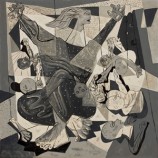The human hand is one of the wonders of Creation. Its fingers are very useful. The ring finger bears a ring, symbol of authority. The pinkie finger; discreet, cleans the ears. Thumbs kill fleas. But it is the index finger that does the most of all… A Latin word, whose meaning comes to “indicate,” the index finger has the obvious function of pointing to, to “indicate.” So significant it is that it spawned the linguistic term: the indicative mood. In primordial ages, it was used for writing.
Just as, in the Book of the Exodus, where we learn that God’s Law, handed to Moses on the heights of a hill, was a work of God’s finger: “After God spoke to Moses on Mount Sinai, He gave him the two Tablets of the Covenant. They were stone tables, written with the finger of God”. (Ex 31,18.)
“To write in stone is synonymous of writing in a definite, lasting, and indelible way. And the Priests of the Church identified this divine “finger” with the Holy Spirit, the third Person of the Trinity: “digitus paternae dexterae,” the right hand finger of the Father. We can understand that the inscription of the commandments was a sort of pyrogravure, a Law cast in stone, carved by flame. In the 8th chapter of Saint John’s Gospel, in a passage unfortunately known as “the adulterous woman,” we can see the importance of the index finger. A group of Pharisees and of scribes, precisely the ones who write, drag to the feet of Jesus a young maiden who had been caught in an adultery act. She must have been engaged to be married, because they wanted to stone her, according to Dt 22,23, while if married, women were to be hung, according to Sifrei 163 of the Talmudic rabbis.
They toss the girl to the ground, in the dust of the patio of the Temple, circling her like a pack of wolves and point at her with the accusing index finger: “Moses ordered this woman to be stoned.” Then, the same index finger turns to Jesus: “And you, what say you?”
The intention is obvious: the enemies of Jesus act in such a way that the preacher of the compassion becomes shock with Moses, and likewise, the Law of Sinai, which would make of him a heretic and be submitted to equal punishment.
To everyone’s surprise, Jesus begins to use his own index finger, to write in the sand. And here we see ourselves before a notable contrast: a Law carved into an indelible rock, and sins written in the fine sand, ground under the feet of pilgrims. Fine sand that even a soft wind could move, erase the writing and null out the phrases…
Yes. The times of the New Covenant were times of compassion. If blood is to be spilt, may it be the blood of the Lamb, not the blood of the sinner. For this reason, facing the insistence of the accusers, Jesus raises his index finger and points to them, “Whoever among you has not sinned, cast the first stone.” Seeing themselves being pointed at, the index finger of the Lord aimed directly at them, they withdraw themselves one by one, starting with the oldest. By logic, he who has lives the most has sinned the most. And with one simple phrase, Jesus changes the judges into culprits.
At this point Jesus could then direct his index finger to the young woman, “Not one of them condemned you?” She whispers, “Not one, my Lord…” And Jesus recoils his index finger to finish with, “Neither do I!”
But the finger of God continues in effect. Jesus points to the blue of the horizon, where the perspective of a new life opens up, showing the way to follow: “Go now… and sin no more…”
Related Articles

















